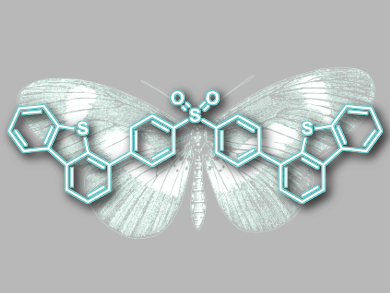Materials that emit white light are useful for displays, sensors, and lighting. Usually, white light is created from at least two colored components. Finding molecules that emit white light directly is much more challenging, especially for molecules with relatively simple structures that are easy to synthesize.
Zhiyong Yang, Yi Zhang, Zhenguo Chi, Sun Yat-Sen University, Guangzhou, China, and colleagues have synthesized two heavy atom-free luminophores with simple molecular structures that can emit white light. The team used Suzuki coupling reactions to substitute diphenylsulfone with either one or two dibenzothiophene groups at the para positions (example pictured). The compounds show fluorescence and room temperature phosphorescence (RTP) in the solid state.
The researchers attribute the molecules’ properties to strong intermolecular contacts and the relatively small energy gaps between singlet and triplet states. The materials also show mechanochromism and thermochromism, i.e., their emission changes from white to blue under mechanical stress or with changing temperatures. According to the team, this is caused by changes to the packing of the molecules, which affect intermolecular interactions.
- White-light emission from a single heavy atom-free molecule with room temperature phosphorescence, mechanochromism and thermochromism,
Bingjia Xu, Haozhong Wu, Junru Chen, Zhan Yang, Zhiyong Yang, Yuan-Chun Wu, Yi Zhang, Chongjun Jin, Po-Yen Lu, Zhenguo Chi, Siwei Liu, Jiarui Xu, Matthew Aldred,
Chem. Sci. 2017.
DOI: 10.1039/c6sc03038f




